Design Thinking Project
VerifiedAdded on 2020/03/16
|17
|4022
|36
Project
AI Summary
The project focuses on the application of Design Thinking in IT, exploring various aspects such as creative design techniques, problem-solving, and the importance of user experience. It includes a series of blogs detailing the learning journey, assessments, and the impact of Design Thinking on in...
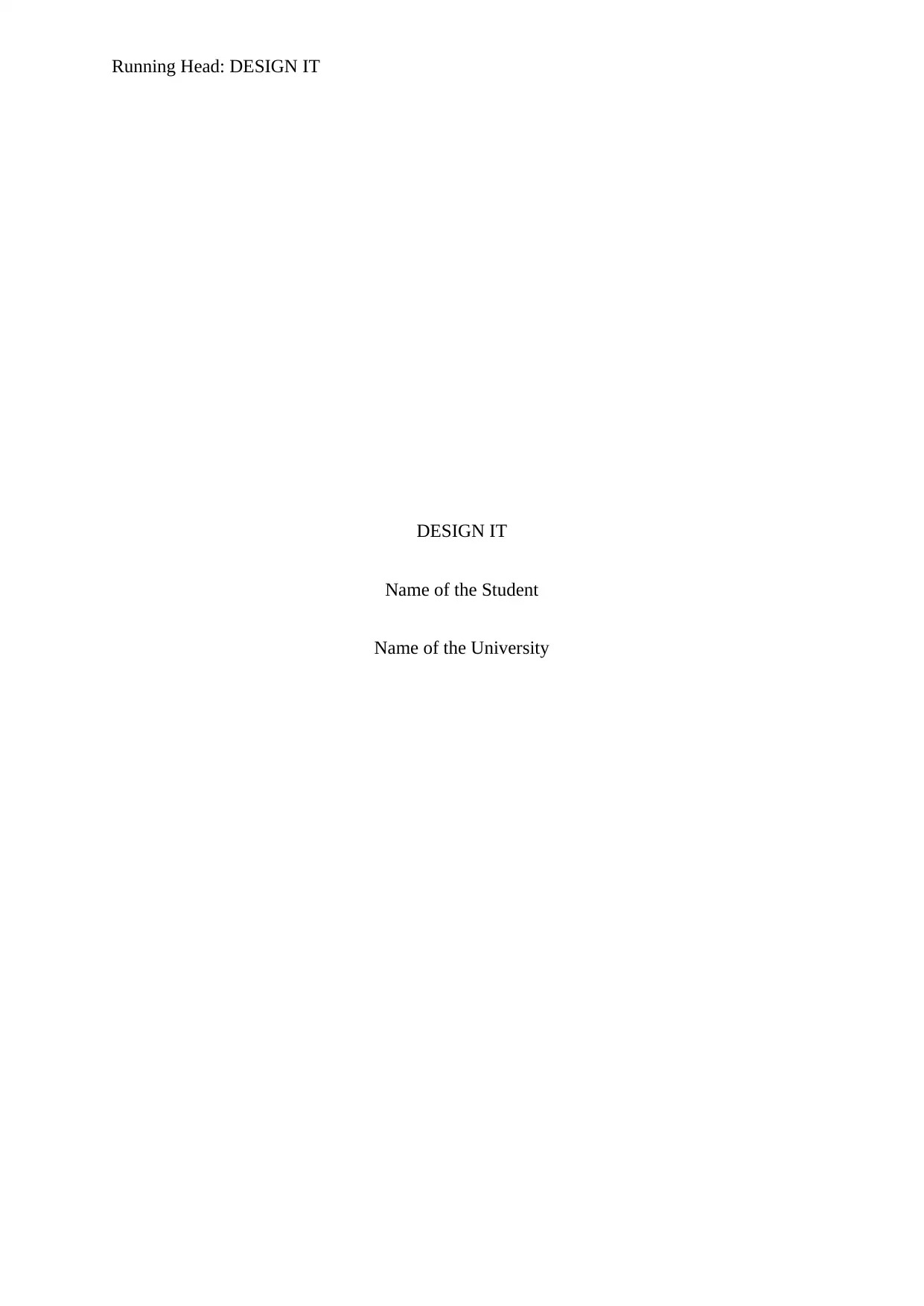
Running Head: DESIGN IT
DESIGN IT
Name of the Student
Name of the University
DESIGN IT
Name of the Student
Name of the University
Paraphrase This Document
Need a fresh take? Get an instant paraphrase of this document with our AI Paraphraser

1DESIGN IT
Executive Summary
The Design Thinking in IT incorporates various aspects to the project teams throughout the
process. There are chances for the students to learn more about the techniques associated with
Creative Design Thinking and thus become familiar to the benefits and obstacles of the
design process. Design Thinking helps the business to raise its profitability and market shares
through improved processes and greater products.
Executive Summary
The Design Thinking in IT incorporates various aspects to the project teams throughout the
process. There are chances for the students to learn more about the techniques associated with
Creative Design Thinking and thus become familiar to the benefits and obstacles of the
design process. Design Thinking helps the business to raise its profitability and market shares
through improved processes and greater products.
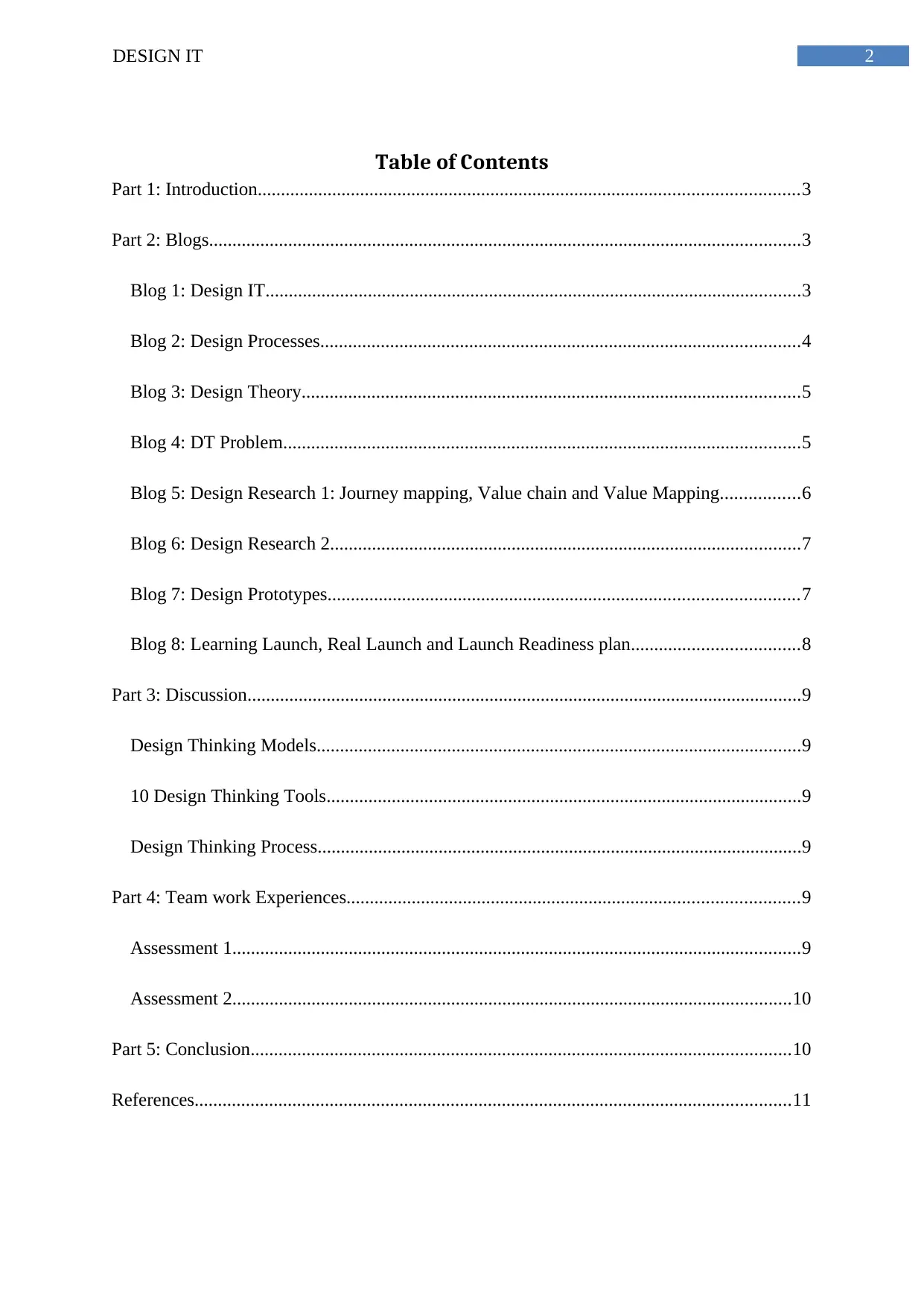
2DESIGN IT
Table of Contents
Part 1: Introduction....................................................................................................................3
Part 2: Blogs...............................................................................................................................3
Blog 1: Design IT...................................................................................................................3
Blog 2: Design Processes.......................................................................................................4
Blog 3: Design Theory...........................................................................................................5
Blog 4: DT Problem...............................................................................................................5
Blog 5: Design Research 1: Journey mapping, Value chain and Value Mapping.................6
Blog 6: Design Research 2.....................................................................................................7
Blog 7: Design Prototypes.....................................................................................................7
Blog 8: Learning Launch, Real Launch and Launch Readiness plan....................................8
Part 3: Discussion.......................................................................................................................9
Design Thinking Models........................................................................................................9
10 Design Thinking Tools......................................................................................................9
Design Thinking Process........................................................................................................9
Part 4: Team work Experiences.................................................................................................9
Assessment 1..........................................................................................................................9
Assessment 2........................................................................................................................10
Part 5: Conclusion....................................................................................................................10
References................................................................................................................................11
Table of Contents
Part 1: Introduction....................................................................................................................3
Part 2: Blogs...............................................................................................................................3
Blog 1: Design IT...................................................................................................................3
Blog 2: Design Processes.......................................................................................................4
Blog 3: Design Theory...........................................................................................................5
Blog 4: DT Problem...............................................................................................................5
Blog 5: Design Research 1: Journey mapping, Value chain and Value Mapping.................6
Blog 6: Design Research 2.....................................................................................................7
Blog 7: Design Prototypes.....................................................................................................7
Blog 8: Learning Launch, Real Launch and Launch Readiness plan....................................8
Part 3: Discussion.......................................................................................................................9
Design Thinking Models........................................................................................................9
10 Design Thinking Tools......................................................................................................9
Design Thinking Process........................................................................................................9
Part 4: Team work Experiences.................................................................................................9
Assessment 1..........................................................................................................................9
Assessment 2........................................................................................................................10
Part 5: Conclusion....................................................................................................................10
References................................................................................................................................11
⊘ This is a preview!⊘
Do you want full access?
Subscribe today to unlock all pages.

Trusted by 1+ million students worldwide

3DESIGN IT
Paraphrase This Document
Need a fresh take? Get an instant paraphrase of this document with our AI Paraphraser
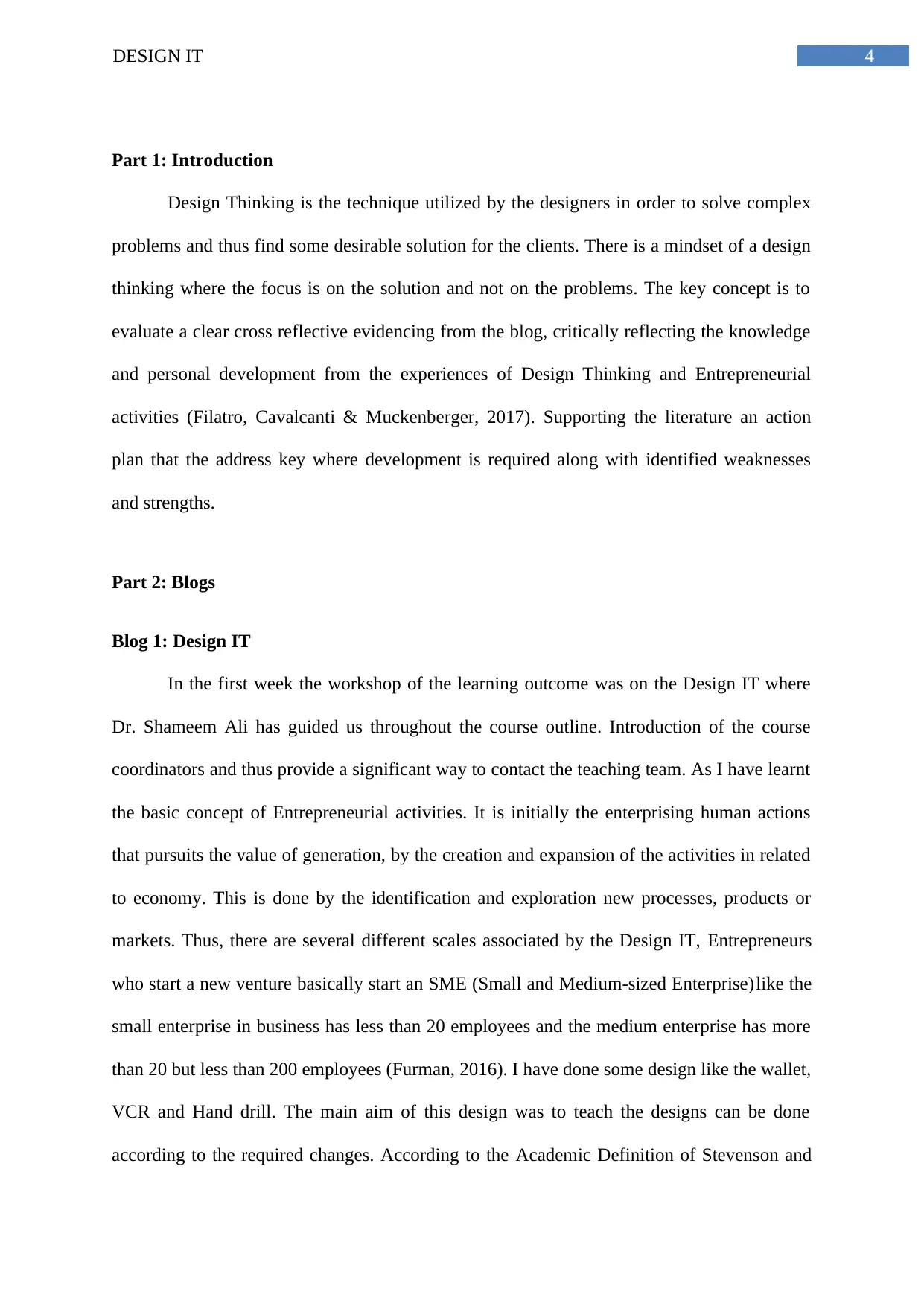
4DESIGN IT
Part 1: Introduction
Design Thinking is the technique utilized by the designers in order to solve complex
problems and thus find some desirable solution for the clients. There is a mindset of a design
thinking where the focus is on the solution and not on the problems. The key concept is to
evaluate a clear cross reflective evidencing from the blog, critically reflecting the knowledge
and personal development from the experiences of Design Thinking and Entrepreneurial
activities (Filatro, Cavalcanti & Muckenberger, 2017). Supporting the literature an action
plan that the address key where development is required along with identified weaknesses
and strengths.
Part 2: Blogs
Blog 1: Design IT
In the first week the workshop of the learning outcome was on the Design IT where
Dr. Shameem Ali has guided us throughout the course outline. Introduction of the course
coordinators and thus provide a significant way to contact the teaching team. As I have learnt
the basic concept of Entrepreneurial activities. It is initially the enterprising human actions
that pursuits the value of generation, by the creation and expansion of the activities in related
to economy. This is done by the identification and exploration new processes, products or
markets. Thus, there are several different scales associated by the Design IT, Entrepreneurs
who start a new venture basically start an SME (Small and Medium-sized Enterprise)like the
small enterprise in business has less than 20 employees and the medium enterprise has more
than 20 but less than 200 employees (Furman, 2016). I have done some design like the wallet,
VCR and Hand drill. The main aim of this design was to teach the designs can be done
according to the required changes. According to the Academic Definition of Stevenson and
Part 1: Introduction
Design Thinking is the technique utilized by the designers in order to solve complex
problems and thus find some desirable solution for the clients. There is a mindset of a design
thinking where the focus is on the solution and not on the problems. The key concept is to
evaluate a clear cross reflective evidencing from the blog, critically reflecting the knowledge
and personal development from the experiences of Design Thinking and Entrepreneurial
activities (Filatro, Cavalcanti & Muckenberger, 2017). Supporting the literature an action
plan that the address key where development is required along with identified weaknesses
and strengths.
Part 2: Blogs
Blog 1: Design IT
In the first week the workshop of the learning outcome was on the Design IT where
Dr. Shameem Ali has guided us throughout the course outline. Introduction of the course
coordinators and thus provide a significant way to contact the teaching team. As I have learnt
the basic concept of Entrepreneurial activities. It is initially the enterprising human actions
that pursuits the value of generation, by the creation and expansion of the activities in related
to economy. This is done by the identification and exploration new processes, products or
markets. Thus, there are several different scales associated by the Design IT, Entrepreneurs
who start a new venture basically start an SME (Small and Medium-sized Enterprise)like the
small enterprise in business has less than 20 employees and the medium enterprise has more
than 20 but less than 200 employees (Furman, 2016). I have done some design like the wallet,
VCR and Hand drill. The main aim of this design was to teach the designs can be done
according to the required changes. According to the Academic Definition of Stevenson and
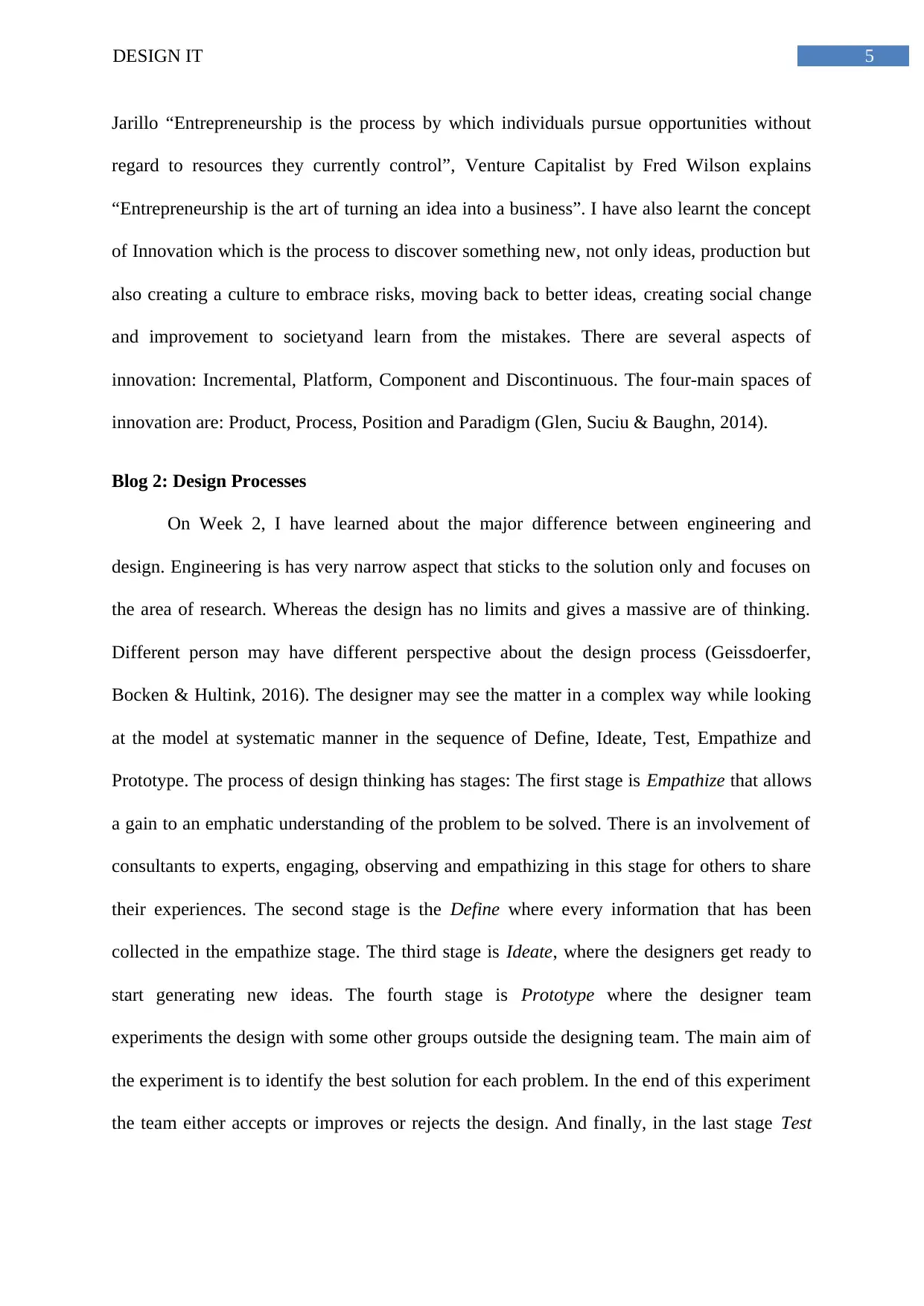
5DESIGN IT
Jarillo “Entrepreneurship is the process by which individuals pursue opportunities without
regard to resources they currently control”, Venture Capitalist by Fred Wilson explains
“Entrepreneurship is the art of turning an idea into a business”. I have also learnt the concept
of Innovation which is the process to discover something new, not only ideas, production but
also creating a culture to embrace risks, moving back to better ideas, creating social change
and improvement to societyand learn from the mistakes. There are several aspects of
innovation: Incremental, Platform, Component and Discontinuous. The four-main spaces of
innovation are: Product, Process, Position and Paradigm (Glen, Suciu & Baughn, 2014).
Blog 2: Design Processes
On Week 2, I have learned about the major difference between engineering and
design. Engineering is has very narrow aspect that sticks to the solution only and focuses on
the area of research. Whereas the design has no limits and gives a massive are of thinking.
Different person may have different perspective about the design process (Geissdoerfer,
Bocken & Hultink, 2016). The designer may see the matter in a complex way while looking
at the model at systematic manner in the sequence of Define, Ideate, Test, Empathize and
Prototype. The process of design thinking has stages: The first stage is Empathize that allows
a gain to an emphatic understanding of the problem to be solved. There is an involvement of
consultants to experts, engaging, observing and empathizing in this stage for others to share
their experiences. The second stage is the Define where every information that has been
collected in the empathize stage. The third stage is Ideate, where the designers get ready to
start generating new ideas. The fourth stage is Prototype where the designer team
experiments the design with some other groups outside the designing team. The main aim of
the experiment is to identify the best solution for each problem. In the end of this experiment
the team either accepts or improves or rejects the design. And finally, in the last stage Test
Jarillo “Entrepreneurship is the process by which individuals pursue opportunities without
regard to resources they currently control”, Venture Capitalist by Fred Wilson explains
“Entrepreneurship is the art of turning an idea into a business”. I have also learnt the concept
of Innovation which is the process to discover something new, not only ideas, production but
also creating a culture to embrace risks, moving back to better ideas, creating social change
and improvement to societyand learn from the mistakes. There are several aspects of
innovation: Incremental, Platform, Component and Discontinuous. The four-main spaces of
innovation are: Product, Process, Position and Paradigm (Glen, Suciu & Baughn, 2014).
Blog 2: Design Processes
On Week 2, I have learned about the major difference between engineering and
design. Engineering is has very narrow aspect that sticks to the solution only and focuses on
the area of research. Whereas the design has no limits and gives a massive are of thinking.
Different person may have different perspective about the design process (Geissdoerfer,
Bocken & Hultink, 2016). The designer may see the matter in a complex way while looking
at the model at systematic manner in the sequence of Define, Ideate, Test, Empathize and
Prototype. The process of design thinking has stages: The first stage is Empathize that allows
a gain to an emphatic understanding of the problem to be solved. There is an involvement of
consultants to experts, engaging, observing and empathizing in this stage for others to share
their experiences. The second stage is the Define where every information that has been
collected in the empathize stage. The third stage is Ideate, where the designers get ready to
start generating new ideas. The fourth stage is Prototype where the designer team
experiments the design with some other groups outside the designing team. The main aim of
the experiment is to identify the best solution for each problem. In the end of this experiment
the team either accepts or improves or rejects the design. And finally, in the last stage Test
⊘ This is a preview!⊘
Do you want full access?
Subscribe today to unlock all pages.

Trusted by 1+ million students worldwide
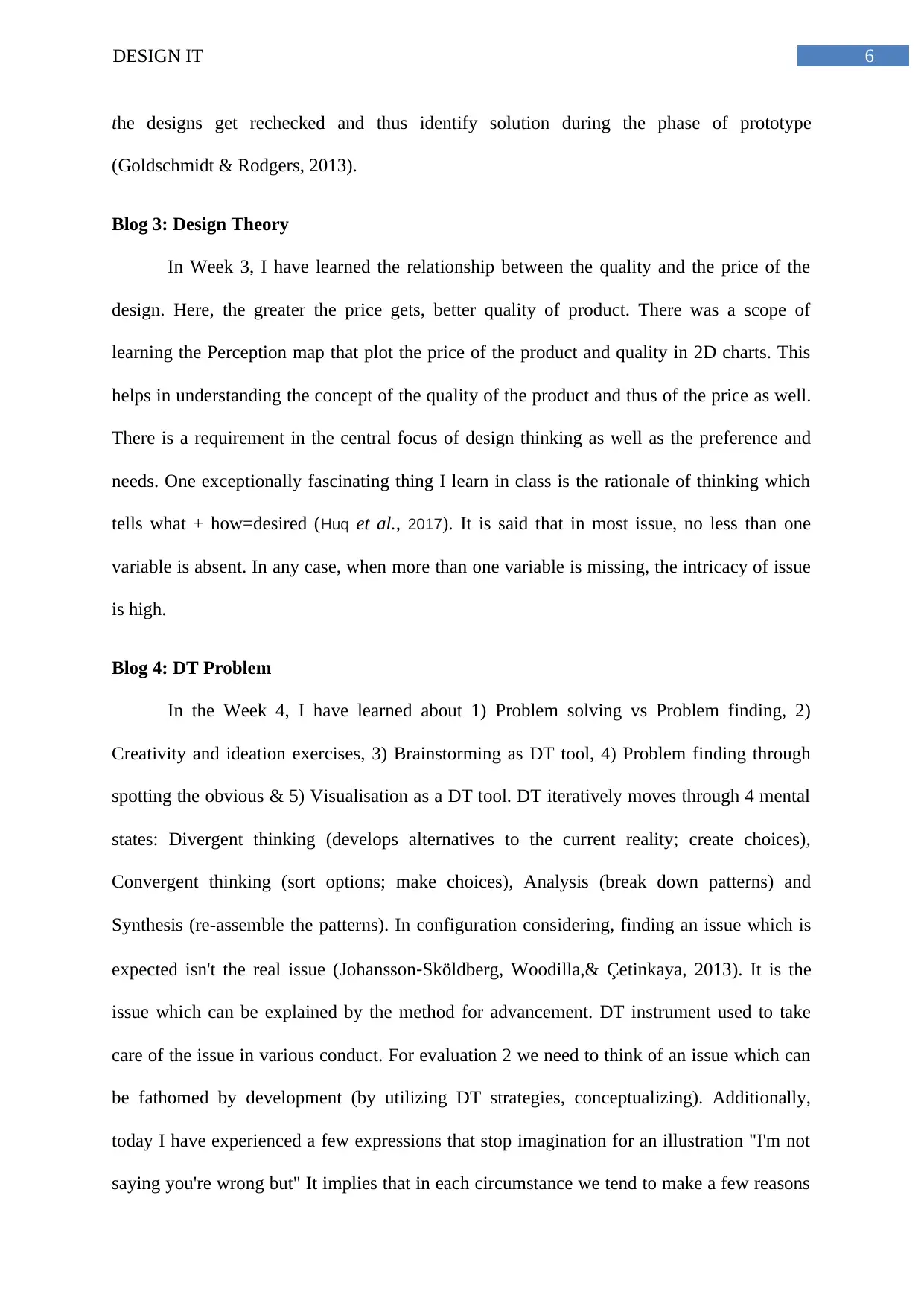
6DESIGN IT
the designs get rechecked and thus identify solution during the phase of prototype
(Goldschmidt & Rodgers, 2013).
Blog 3: Design Theory
In Week 3, I have learned the relationship between the quality and the price of the
design. Here, the greater the price gets, better quality of product. There was a scope of
learning the Perception map that plot the price of the product and quality in 2D charts. This
helps in understanding the concept of the quality of the product and thus of the price as well.
There is a requirement in the central focus of design thinking as well as the preference and
needs. One exceptionally fascinating thing I learn in class is the rationale of thinking which
tells what + how=desired (Huq et al., 2017). It is said that in most issue, no less than one
variable is absent. In any case, when more than one variable is missing, the intricacy of issue
is high.
Blog 4: DT Problem
In the Week 4, I have learned about 1) Problem solving vs Problem finding, 2)
Creativity and ideation exercises, 3) Brainstorming as DT tool, 4) Problem finding through
spotting the obvious & 5) Visualisation as a DT tool. DT iteratively moves through 4 mental
states: Divergent thinking (develops alternatives to the current reality; create choices),
Convergent thinking (sort options; make choices), Analysis (break down patterns) and
Synthesis (re-assemble the patterns). In configuration considering, finding an issue which is
expected isn't the real issue (Johansson‐Sköldberg, Woodilla,& Çetinkaya, 2013). It is the
issue which can be explained by the method for advancement. DT instrument used to take
care of the issue in various conduct. For evaluation 2 we need to think of an issue which can
be fathomed by development (by utilizing DT strategies, conceptualizing). Additionally,
today I have experienced a few expressions that stop imagination for an illustration "I'm not
saying you're wrong but" It implies that in each circumstance we tend to make a few reasons
the designs get rechecked and thus identify solution during the phase of prototype
(Goldschmidt & Rodgers, 2013).
Blog 3: Design Theory
In Week 3, I have learned the relationship between the quality and the price of the
design. Here, the greater the price gets, better quality of product. There was a scope of
learning the Perception map that plot the price of the product and quality in 2D charts. This
helps in understanding the concept of the quality of the product and thus of the price as well.
There is a requirement in the central focus of design thinking as well as the preference and
needs. One exceptionally fascinating thing I learn in class is the rationale of thinking which
tells what + how=desired (Huq et al., 2017). It is said that in most issue, no less than one
variable is absent. In any case, when more than one variable is missing, the intricacy of issue
is high.
Blog 4: DT Problem
In the Week 4, I have learned about 1) Problem solving vs Problem finding, 2)
Creativity and ideation exercises, 3) Brainstorming as DT tool, 4) Problem finding through
spotting the obvious & 5) Visualisation as a DT tool. DT iteratively moves through 4 mental
states: Divergent thinking (develops alternatives to the current reality; create choices),
Convergent thinking (sort options; make choices), Analysis (break down patterns) and
Synthesis (re-assemble the patterns). In configuration considering, finding an issue which is
expected isn't the real issue (Johansson‐Sköldberg, Woodilla,& Çetinkaya, 2013). It is the
issue which can be explained by the method for advancement. DT instrument used to take
care of the issue in various conduct. For evaluation 2 we need to think of an issue which can
be fathomed by development (by utilizing DT strategies, conceptualizing). Additionally,
today I have experienced a few expressions that stop imagination for an illustration "I'm not
saying you're wrong but" It implies that in each circumstance we tend to make a few reasons
Paraphrase This Document
Need a fresh take? Get an instant paraphrase of this document with our AI Paraphraser
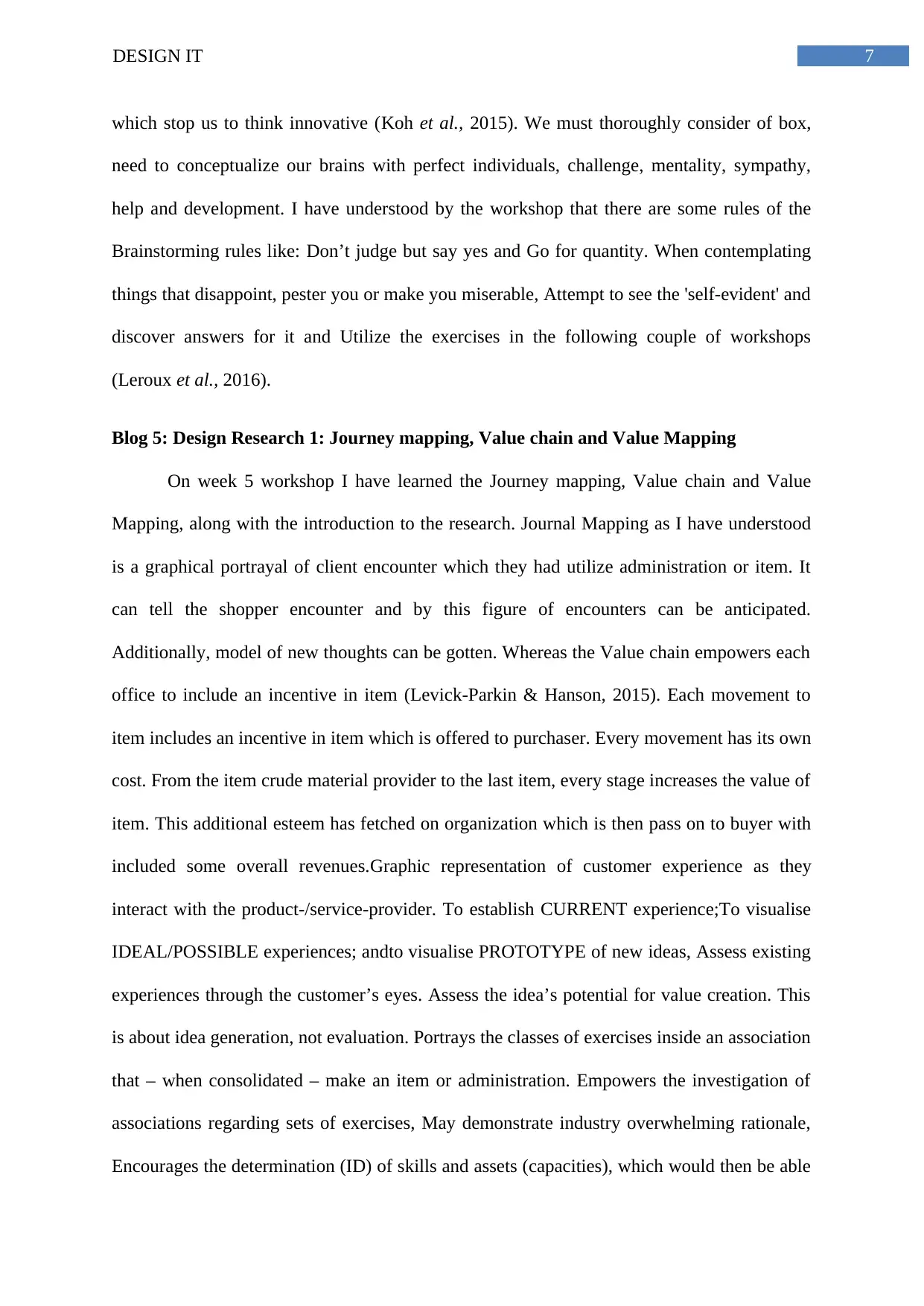
7DESIGN IT
which stop us to think innovative (Koh et al., 2015). We must thoroughly consider of box,
need to conceptualize our brains with perfect individuals, challenge, mentality, sympathy,
help and development. I have understood by the workshop that there are some rules of the
Brainstorming rules like: Don’t judge but say yes and Go for quantity. When contemplating
things that disappoint, pester you or make you miserable, Attempt to see the 'self-evident' and
discover answers for it and Utilize the exercises in the following couple of workshops
(Leroux et al., 2016).
Blog 5: Design Research 1: Journey mapping, Value chain and Value Mapping
On week 5 workshop I have learned the Journey mapping, Value chain and Value
Mapping, along with the introduction to the research. Journal Mapping as I have understood
is a graphical portrayal of client encounter which they had utilize administration or item. It
can tell the shopper encounter and by this figure of encounters can be anticipated.
Additionally, model of new thoughts can be gotten. Whereas the Value chain empowers each
office to include an incentive in item (Levick-Parkin & Hanson, 2015). Each movement to
item includes an incentive in item which is offered to purchaser. Every movement has its own
cost. From the item crude material provider to the last item, every stage increases the value of
item. This additional esteem has fetched on organization which is then pass on to buyer with
included some overall revenues.Graphic representation of customer experience as they
interact with the product-/service-provider. To establish CURRENT experience;To visualise
IDEAL/POSSIBLE experiences; andto visualise PROTOTYPE of new ideas, Assess existing
experiences through the customer’s eyes. Assess the idea’s potential for value creation. This
is about idea generation, not evaluation. Portrays the classes of exercises inside an association
that – when consolidated – make an item or administration. Empowers the investigation of
associations regarding sets of exercises, May demonstrate industry overwhelming rationale,
Encourages the determination (ID) of skills and assets (capacities), which would then be able
which stop us to think innovative (Koh et al., 2015). We must thoroughly consider of box,
need to conceptualize our brains with perfect individuals, challenge, mentality, sympathy,
help and development. I have understood by the workshop that there are some rules of the
Brainstorming rules like: Don’t judge but say yes and Go for quantity. When contemplating
things that disappoint, pester you or make you miserable, Attempt to see the 'self-evident' and
discover answers for it and Utilize the exercises in the following couple of workshops
(Leroux et al., 2016).
Blog 5: Design Research 1: Journey mapping, Value chain and Value Mapping
On week 5 workshop I have learned the Journey mapping, Value chain and Value
Mapping, along with the introduction to the research. Journal Mapping as I have understood
is a graphical portrayal of client encounter which they had utilize administration or item. It
can tell the shopper encounter and by this figure of encounters can be anticipated.
Additionally, model of new thoughts can be gotten. Whereas the Value chain empowers each
office to include an incentive in item (Levick-Parkin & Hanson, 2015). Each movement to
item includes an incentive in item which is offered to purchaser. Every movement has its own
cost. From the item crude material provider to the last item, every stage increases the value of
item. This additional esteem has fetched on organization which is then pass on to buyer with
included some overall revenues.Graphic representation of customer experience as they
interact with the product-/service-provider. To establish CURRENT experience;To visualise
IDEAL/POSSIBLE experiences; andto visualise PROTOTYPE of new ideas, Assess existing
experiences through the customer’s eyes. Assess the idea’s potential for value creation. This
is about idea generation, not evaluation. Portrays the classes of exercises inside an association
that – when consolidated – make an item or administration. Empowers the investigation of
associations regarding sets of exercises, May demonstrate industry overwhelming rationale,
Encourages the determination (ID) of skills and assets (capacities), which would then be able
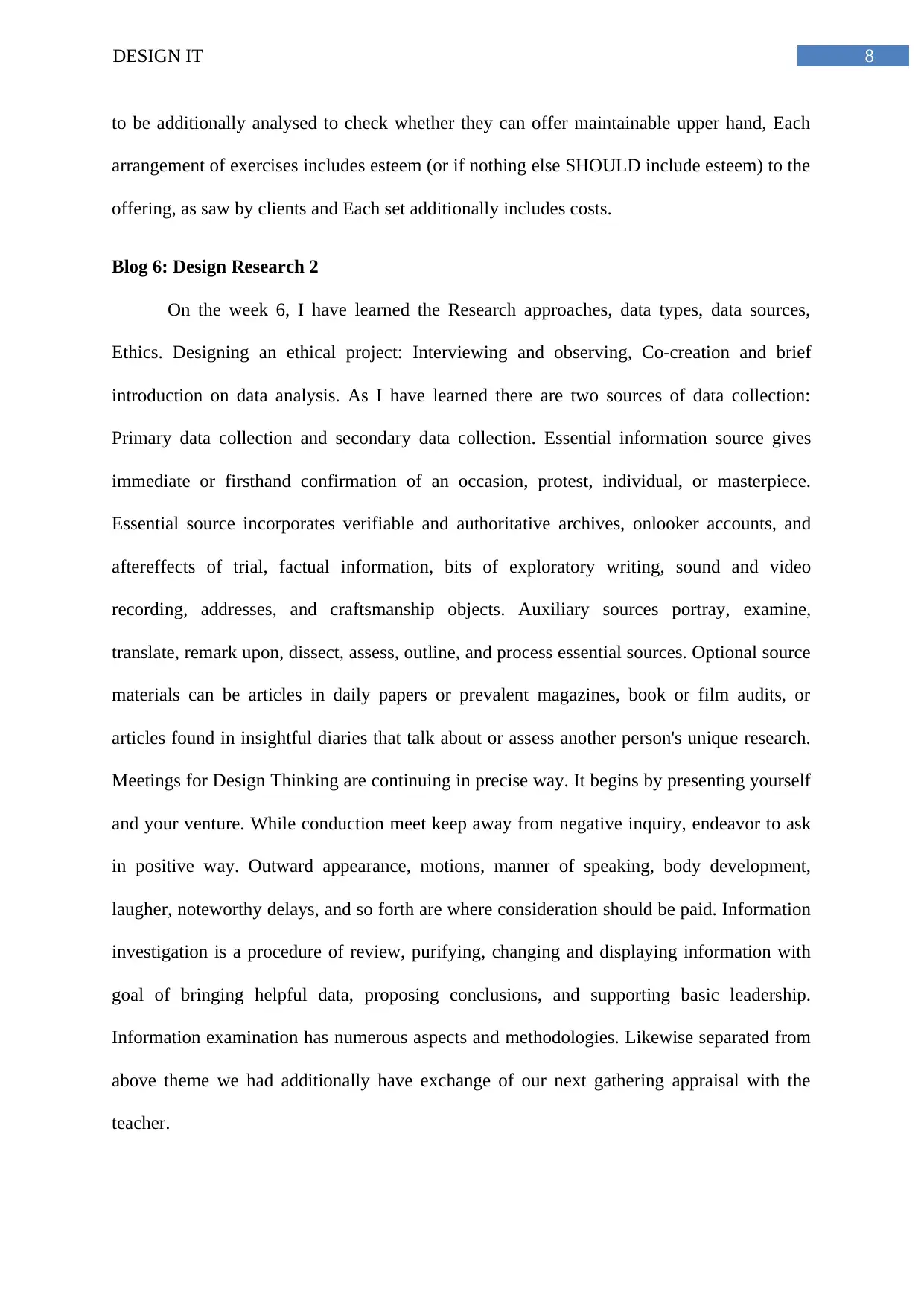
8DESIGN IT
to be additionally analysed to check whether they can offer maintainable upper hand, Each
arrangement of exercises includes esteem (or if nothing else SHOULD include esteem) to the
offering, as saw by clients and Each set additionally includes costs.
Blog 6: Design Research 2
On the week 6, I have learned the Research approaches, data types, data sources,
Ethics. Designing an ethical project: Interviewing and observing, Co-creation and brief
introduction on data analysis. As I have learned there are two sources of data collection:
Primary data collection and secondary data collection. Essential information source gives
immediate or firsthand confirmation of an occasion, protest, individual, or masterpiece.
Essential source incorporates verifiable and authoritative archives, onlooker accounts, and
aftereffects of trial, factual information, bits of exploratory writing, sound and video
recording, addresses, and craftsmanship objects. Auxiliary sources portray, examine,
translate, remark upon, dissect, assess, outline, and process essential sources. Optional source
materials can be articles in daily papers or prevalent magazines, book or film audits, or
articles found in insightful diaries that talk about or assess another person's unique research.
Meetings for Design Thinking are continuing in precise way. It begins by presenting yourself
and your venture. While conduction meet keep away from negative inquiry, endeavor to ask
in positive way. Outward appearance, motions, manner of speaking, body development,
laugher, noteworthy delays, and so forth are where consideration should be paid. Information
investigation is a procedure of review, purifying, changing and displaying information with
goal of bringing helpful data, proposing conclusions, and supporting basic leadership.
Information examination has numerous aspects and methodologies. Likewise separated from
above theme we had additionally have exchange of our next gathering appraisal with the
teacher.
to be additionally analysed to check whether they can offer maintainable upper hand, Each
arrangement of exercises includes esteem (or if nothing else SHOULD include esteem) to the
offering, as saw by clients and Each set additionally includes costs.
Blog 6: Design Research 2
On the week 6, I have learned the Research approaches, data types, data sources,
Ethics. Designing an ethical project: Interviewing and observing, Co-creation and brief
introduction on data analysis. As I have learned there are two sources of data collection:
Primary data collection and secondary data collection. Essential information source gives
immediate or firsthand confirmation of an occasion, protest, individual, or masterpiece.
Essential source incorporates verifiable and authoritative archives, onlooker accounts, and
aftereffects of trial, factual information, bits of exploratory writing, sound and video
recording, addresses, and craftsmanship objects. Auxiliary sources portray, examine,
translate, remark upon, dissect, assess, outline, and process essential sources. Optional source
materials can be articles in daily papers or prevalent magazines, book or film audits, or
articles found in insightful diaries that talk about or assess another person's unique research.
Meetings for Design Thinking are continuing in precise way. It begins by presenting yourself
and your venture. While conduction meet keep away from negative inquiry, endeavor to ask
in positive way. Outward appearance, motions, manner of speaking, body development,
laugher, noteworthy delays, and so forth are where consideration should be paid. Information
investigation is a procedure of review, purifying, changing and displaying information with
goal of bringing helpful data, proposing conclusions, and supporting basic leadership.
Information examination has numerous aspects and methodologies. Likewise separated from
above theme we had additionally have exchange of our next gathering appraisal with the
teacher.
⊘ This is a preview!⊘
Do you want full access?
Subscribe today to unlock all pages.

Trusted by 1+ million students worldwide
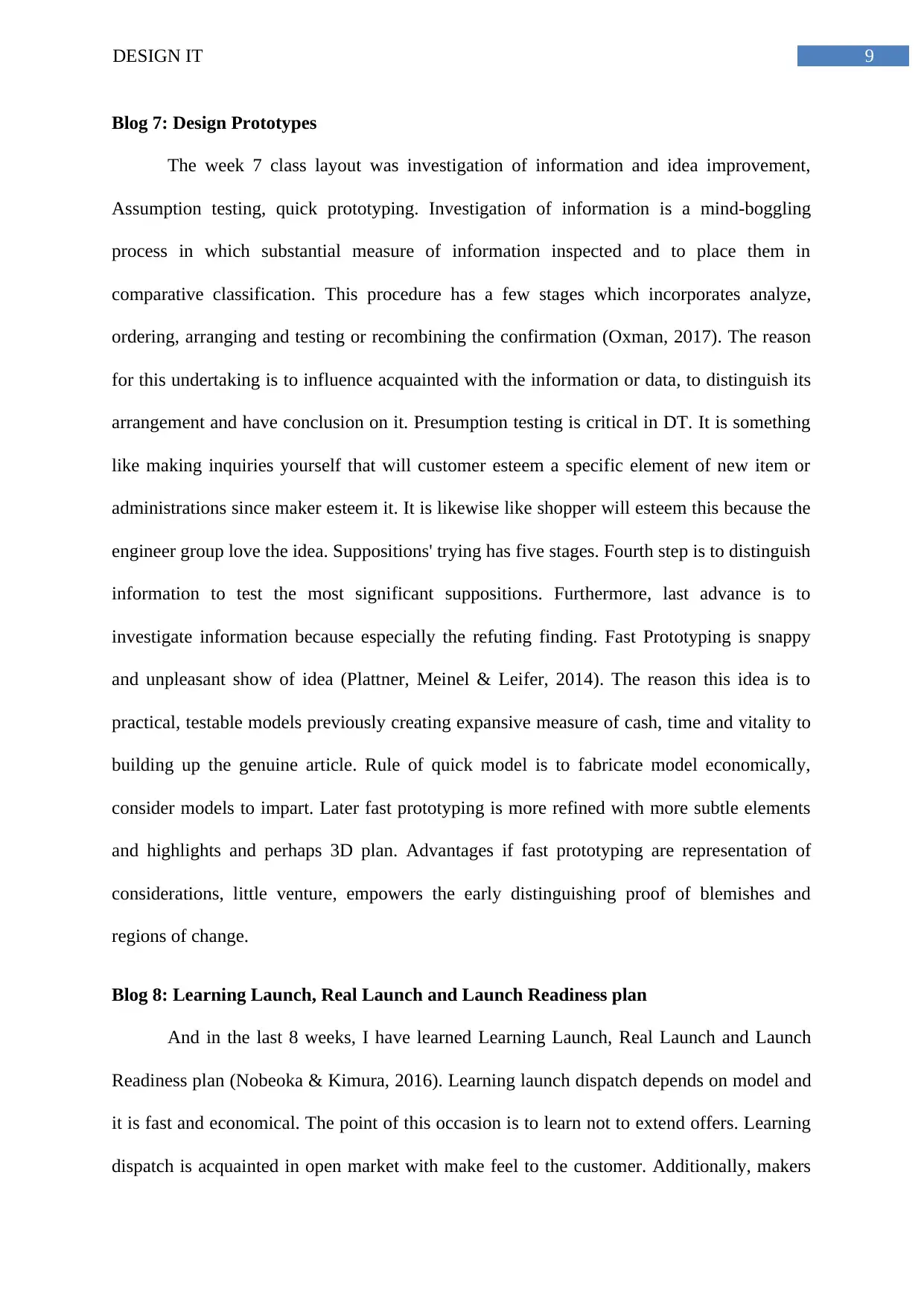
9DESIGN IT
Blog 7: Design Prototypes
The week 7 class layout was investigation of information and idea improvement,
Assumption testing, quick prototyping. Investigation of information is a mind-boggling
process in which substantial measure of information inspected and to place them in
comparative classification. This procedure has a few stages which incorporates analyze,
ordering, arranging and testing or recombining the confirmation (Oxman, 2017). The reason
for this undertaking is to influence acquainted with the information or data, to distinguish its
arrangement and have conclusion on it. Presumption testing is critical in DT. It is something
like making inquiries yourself that will customer esteem a specific element of new item or
administrations since maker esteem it. It is likewise like shopper will esteem this because the
engineer group love the idea. Suppositions' trying has five stages. Fourth step is to distinguish
information to test the most significant suppositions. Furthermore, last advance is to
investigate information because especially the refuting finding. Fast Prototyping is snappy
and unpleasant show of idea (Plattner, Meinel & Leifer, 2014). The reason this idea is to
practical, testable models previously creating expansive measure of cash, time and vitality to
building up the genuine article. Rule of quick model is to fabricate model economically,
consider models to impart. Later fast prototyping is more refined with more subtle elements
and highlights and perhaps 3D plan. Advantages if fast prototyping are representation of
considerations, little venture, empowers the early distinguishing proof of blemishes and
regions of change.
Blog 8: Learning Launch, Real Launch and Launch Readiness plan
And in the last 8 weeks, I have learned Learning Launch, Real Launch and Launch
Readiness plan (Nobeoka & Kimura, 2016). Learning launch dispatch depends on model and
it is fast and economical. The point of this occasion is to learn not to extend offers. Learning
dispatch is acquainted in open market with make feel to the customer. Additionally, makers
Blog 7: Design Prototypes
The week 7 class layout was investigation of information and idea improvement,
Assumption testing, quick prototyping. Investigation of information is a mind-boggling
process in which substantial measure of information inspected and to place them in
comparative classification. This procedure has a few stages which incorporates analyze,
ordering, arranging and testing or recombining the confirmation (Oxman, 2017). The reason
for this undertaking is to influence acquainted with the information or data, to distinguish its
arrangement and have conclusion on it. Presumption testing is critical in DT. It is something
like making inquiries yourself that will customer esteem a specific element of new item or
administrations since maker esteem it. It is likewise like shopper will esteem this because the
engineer group love the idea. Suppositions' trying has five stages. Fourth step is to distinguish
information to test the most significant suppositions. Furthermore, last advance is to
investigate information because especially the refuting finding. Fast Prototyping is snappy
and unpleasant show of idea (Plattner, Meinel & Leifer, 2014). The reason this idea is to
practical, testable models previously creating expansive measure of cash, time and vitality to
building up the genuine article. Rule of quick model is to fabricate model economically,
consider models to impart. Later fast prototyping is more refined with more subtle elements
and highlights and perhaps 3D plan. Advantages if fast prototyping are representation of
considerations, little venture, empowers the early distinguishing proof of blemishes and
regions of change.
Blog 8: Learning Launch, Real Launch and Launch Readiness plan
And in the last 8 weeks, I have learned Learning Launch, Real Launch and Launch
Readiness plan (Nobeoka & Kimura, 2016). Learning launch dispatch depends on model and
it is fast and economical. The point of this occasion is to learn not to extend offers. Learning
dispatch is acquainted in open market with make feel to the customer. Additionally, makers
Paraphrase This Document
Need a fresh take? Get an instant paraphrase of this document with our AI Paraphraser
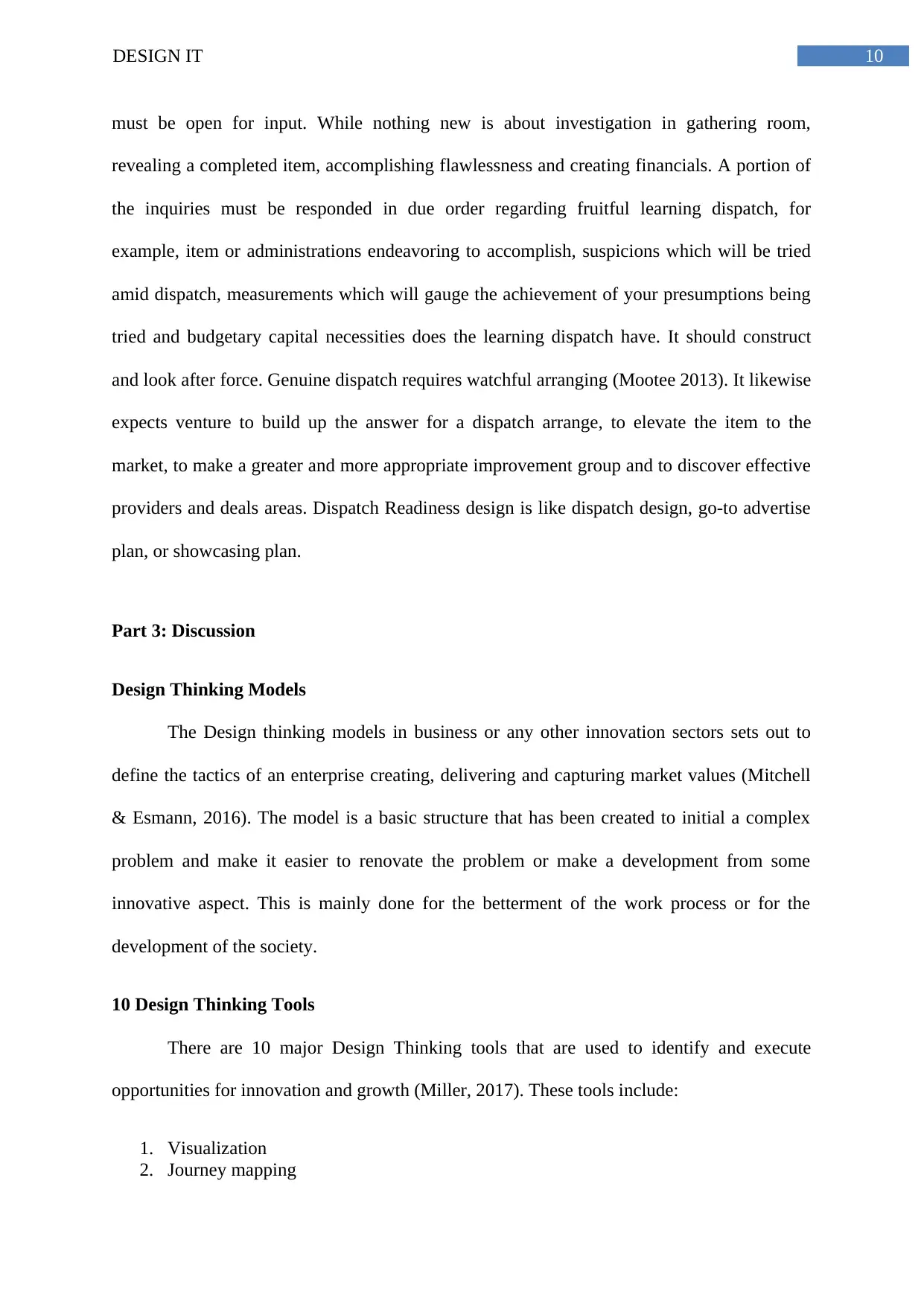
10DESIGN IT
must be open for input. While nothing new is about investigation in gathering room,
revealing a completed item, accomplishing flawlessness and creating financials. A portion of
the inquiries must be responded in due order regarding fruitful learning dispatch, for
example, item or administrations endeavoring to accomplish, suspicions which will be tried
amid dispatch, measurements which will gauge the achievement of your presumptions being
tried and budgetary capital necessities does the learning dispatch have. It should construct
and look after force. Genuine dispatch requires watchful arranging (Mootee 2013). It likewise
expects venture to build up the answer for a dispatch arrange, to elevate the item to the
market, to make a greater and more appropriate improvement group and to discover effective
providers and deals areas. Dispatch Readiness design is like dispatch design, go-to advertise
plan, or showcasing plan.
Part 3: Discussion
Design Thinking Models
The Design thinking models in business or any other innovation sectors sets out to
define the tactics of an enterprise creating, delivering and capturing market values (Mitchell
& Esmann, 2016). The model is a basic structure that has been created to initial a complex
problem and make it easier to renovate the problem or make a development from some
innovative aspect. This is mainly done for the betterment of the work process or for the
development of the society.
10 Design Thinking Tools
There are 10 major Design Thinking tools that are used to identify and execute
opportunities for innovation and growth (Miller, 2017). These tools include:
1. Visualization
2. Journey mapping
must be open for input. While nothing new is about investigation in gathering room,
revealing a completed item, accomplishing flawlessness and creating financials. A portion of
the inquiries must be responded in due order regarding fruitful learning dispatch, for
example, item or administrations endeavoring to accomplish, suspicions which will be tried
amid dispatch, measurements which will gauge the achievement of your presumptions being
tried and budgetary capital necessities does the learning dispatch have. It should construct
and look after force. Genuine dispatch requires watchful arranging (Mootee 2013). It likewise
expects venture to build up the answer for a dispatch arrange, to elevate the item to the
market, to make a greater and more appropriate improvement group and to discover effective
providers and deals areas. Dispatch Readiness design is like dispatch design, go-to advertise
plan, or showcasing plan.
Part 3: Discussion
Design Thinking Models
The Design thinking models in business or any other innovation sectors sets out to
define the tactics of an enterprise creating, delivering and capturing market values (Mitchell
& Esmann, 2016). The model is a basic structure that has been created to initial a complex
problem and make it easier to renovate the problem or make a development from some
innovative aspect. This is mainly done for the betterment of the work process or for the
development of the society.
10 Design Thinking Tools
There are 10 major Design Thinking tools that are used to identify and execute
opportunities for innovation and growth (Miller, 2017). These tools include:
1. Visualization
2. Journey mapping
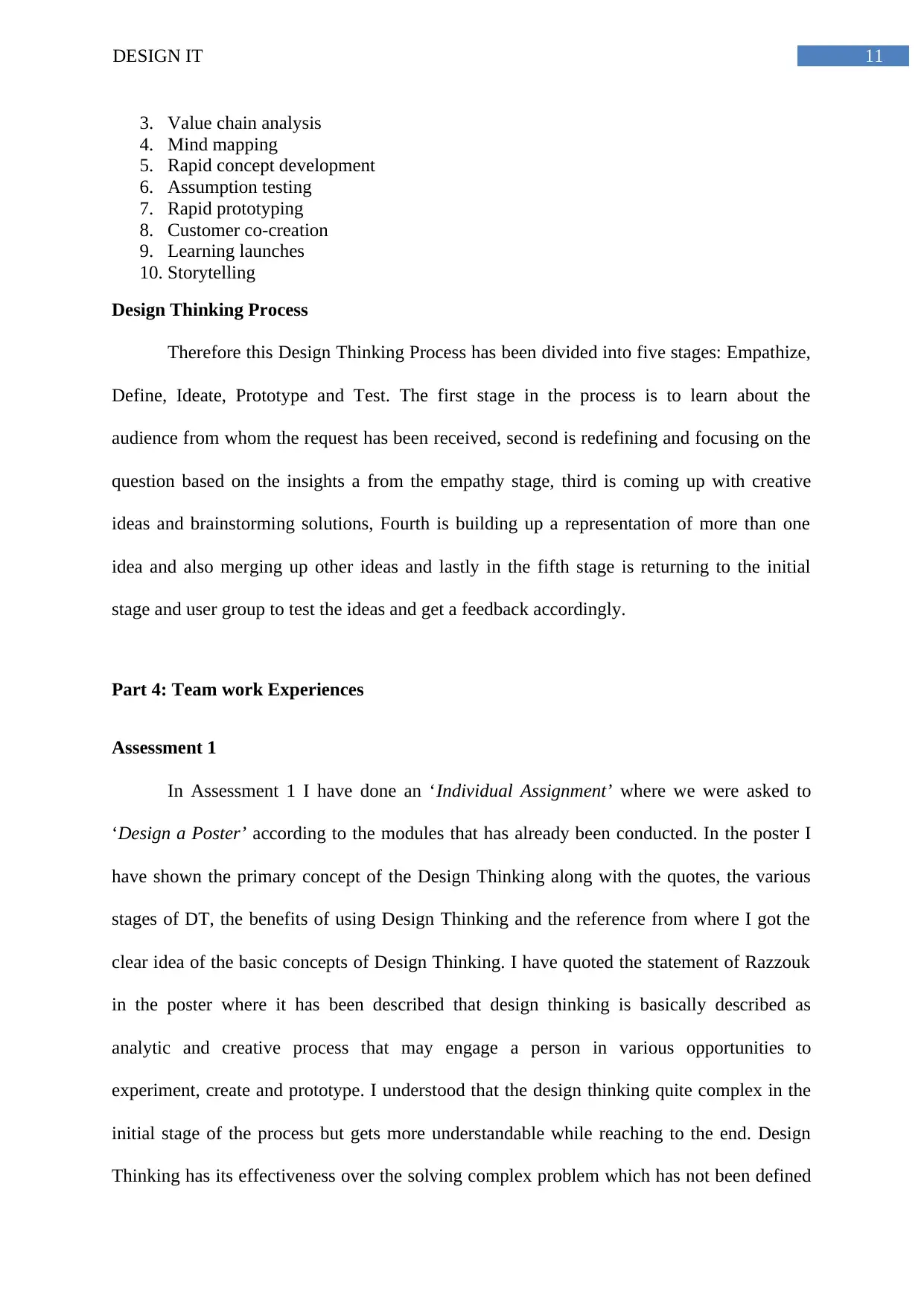
11DESIGN IT
3. Value chain analysis
4. Mind mapping
5. Rapid concept development
6. Assumption testing
7. Rapid prototyping
8. Customer co-creation
9. Learning launches
10. Storytelling
Design Thinking Process
Therefore this Design Thinking Process has been divided into five stages: Empathize,
Define, Ideate, Prototype and Test. The first stage in the process is to learn about the
audience from whom the request has been received, second is redefining and focusing on the
question based on the insights a from the empathy stage, third is coming up with creative
ideas and brainstorming solutions, Fourth is building up a representation of more than one
idea and also merging up other ideas and lastly in the fifth stage is returning to the initial
stage and user group to test the ideas and get a feedback accordingly.
Part 4: Team work Experiences
Assessment 1
In Assessment 1 I have done an ‘Individual Assignment’ where we were asked to
‘Design a Poster’ according to the modules that has already been conducted. In the poster I
have shown the primary concept of the Design Thinking along with the quotes, the various
stages of DT, the benefits of using Design Thinking and the reference from where I got the
clear idea of the basic concepts of Design Thinking. I have quoted the statement of Razzouk
in the poster where it has been described that design thinking is basically described as
analytic and creative process that may engage a person in various opportunities to
experiment, create and prototype. I understood that the design thinking quite complex in the
initial stage of the process but gets more understandable while reaching to the end. Design
Thinking has its effectiveness over the solving complex problem which has not been defined
3. Value chain analysis
4. Mind mapping
5. Rapid concept development
6. Assumption testing
7. Rapid prototyping
8. Customer co-creation
9. Learning launches
10. Storytelling
Design Thinking Process
Therefore this Design Thinking Process has been divided into five stages: Empathize,
Define, Ideate, Prototype and Test. The first stage in the process is to learn about the
audience from whom the request has been received, second is redefining and focusing on the
question based on the insights a from the empathy stage, third is coming up with creative
ideas and brainstorming solutions, Fourth is building up a representation of more than one
idea and also merging up other ideas and lastly in the fifth stage is returning to the initial
stage and user group to test the ideas and get a feedback accordingly.
Part 4: Team work Experiences
Assessment 1
In Assessment 1 I have done an ‘Individual Assignment’ where we were asked to
‘Design a Poster’ according to the modules that has already been conducted. In the poster I
have shown the primary concept of the Design Thinking along with the quotes, the various
stages of DT, the benefits of using Design Thinking and the reference from where I got the
clear idea of the basic concepts of Design Thinking. I have quoted the statement of Razzouk
in the poster where it has been described that design thinking is basically described as
analytic and creative process that may engage a person in various opportunities to
experiment, create and prototype. I understood that the design thinking quite complex in the
initial stage of the process but gets more understandable while reaching to the end. Design
Thinking has its effectiveness over the solving complex problem which has not been defined
⊘ This is a preview!⊘
Do you want full access?
Subscribe today to unlock all pages.

Trusted by 1+ million students worldwide
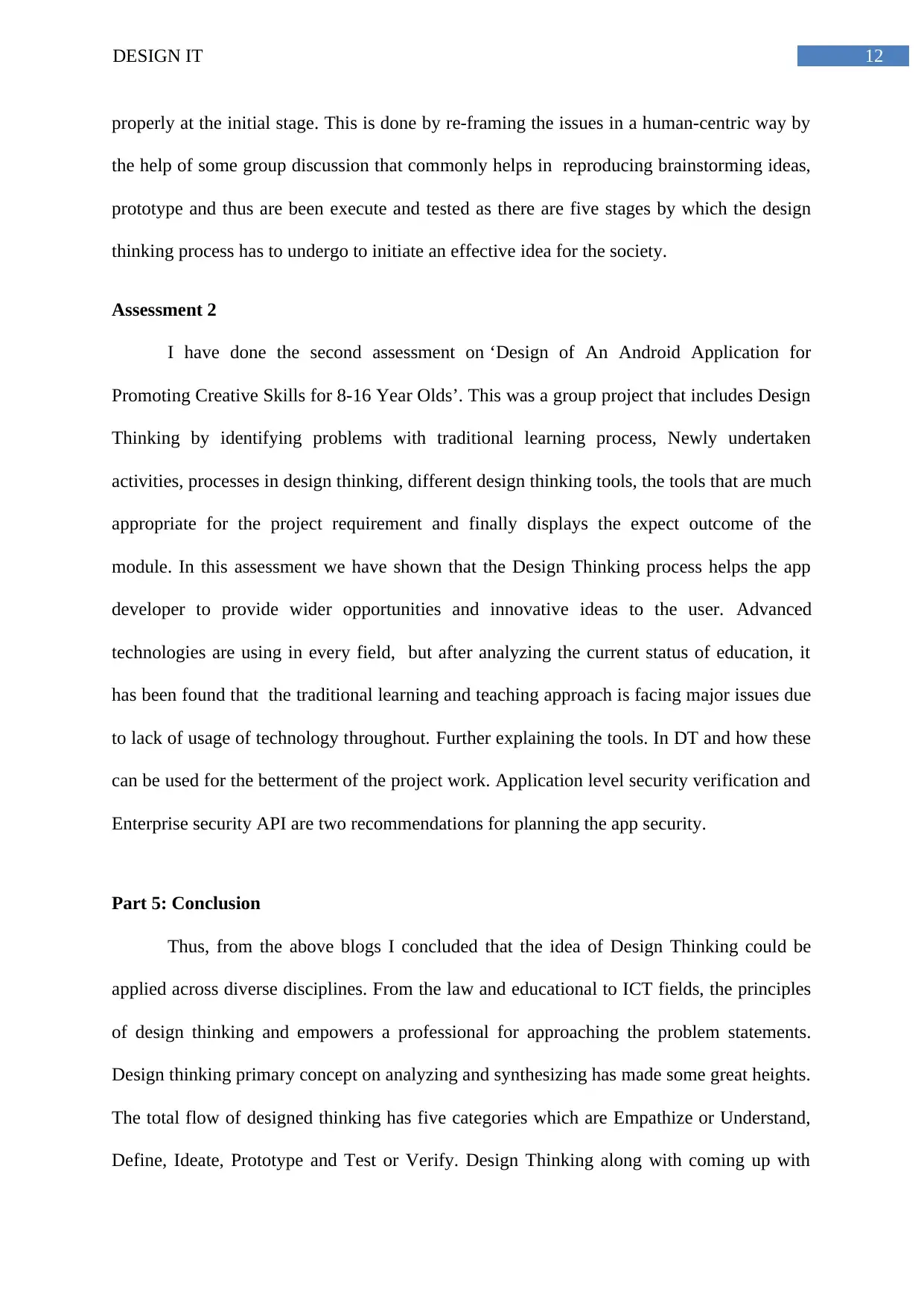
12DESIGN IT
properly at the initial stage. This is done by re-framing the issues in a human-centric way by
the help of some group discussion that commonly helps in reproducing brainstorming ideas,
prototype and thus are been execute and tested as there are five stages by which the design
thinking process has to undergo to initiate an effective idea for the society.
Assessment 2
I have done the second assessment on ‘Design of An Android Application for
Promoting Creative Skills for 8-16 Year Olds’. This was a group project that includes Design
Thinking by identifying problems with traditional learning process, Newly undertaken
activities, processes in design thinking, different design thinking tools, the tools that are much
appropriate for the project requirement and finally displays the expect outcome of the
module. In this assessment we have shown that the Design Thinking process helps the app
developer to provide wider opportunities and innovative ideas to the user. Advanced
technologies are using in every field, but after analyzing the current status of education, it
has been found that the traditional learning and teaching approach is facing major issues due
to lack of usage of technology throughout. Further explaining the tools. In DT and how these
can be used for the betterment of the project work. Application level security verification and
Enterprise security API are two recommendations for planning the app security.
Part 5: Conclusion
Thus, from the above blogs I concluded that the idea of Design Thinking could be
applied across diverse disciplines. From the law and educational to ICT fields, the principles
of design thinking and empowers a professional for approaching the problem statements.
Design thinking primary concept on analyzing and synthesizing has made some great heights.
The total flow of designed thinking has five categories which are Empathize or Understand,
Define, Ideate, Prototype and Test or Verify. Design Thinking along with coming up with
properly at the initial stage. This is done by re-framing the issues in a human-centric way by
the help of some group discussion that commonly helps in reproducing brainstorming ideas,
prototype and thus are been execute and tested as there are five stages by which the design
thinking process has to undergo to initiate an effective idea for the society.
Assessment 2
I have done the second assessment on ‘Design of An Android Application for
Promoting Creative Skills for 8-16 Year Olds’. This was a group project that includes Design
Thinking by identifying problems with traditional learning process, Newly undertaken
activities, processes in design thinking, different design thinking tools, the tools that are much
appropriate for the project requirement and finally displays the expect outcome of the
module. In this assessment we have shown that the Design Thinking process helps the app
developer to provide wider opportunities and innovative ideas to the user. Advanced
technologies are using in every field, but after analyzing the current status of education, it
has been found that the traditional learning and teaching approach is facing major issues due
to lack of usage of technology throughout. Further explaining the tools. In DT and how these
can be used for the betterment of the project work. Application level security verification and
Enterprise security API are two recommendations for planning the app security.
Part 5: Conclusion
Thus, from the above blogs I concluded that the idea of Design Thinking could be
applied across diverse disciplines. From the law and educational to ICT fields, the principles
of design thinking and empowers a professional for approaching the problem statements.
Design thinking primary concept on analyzing and synthesizing has made some great heights.
The total flow of designed thinking has five categories which are Empathize or Understand,
Define, Ideate, Prototype and Test or Verify. Design Thinking along with coming up with
Paraphrase This Document
Need a fresh take? Get an instant paraphrase of this document with our AI Paraphraser
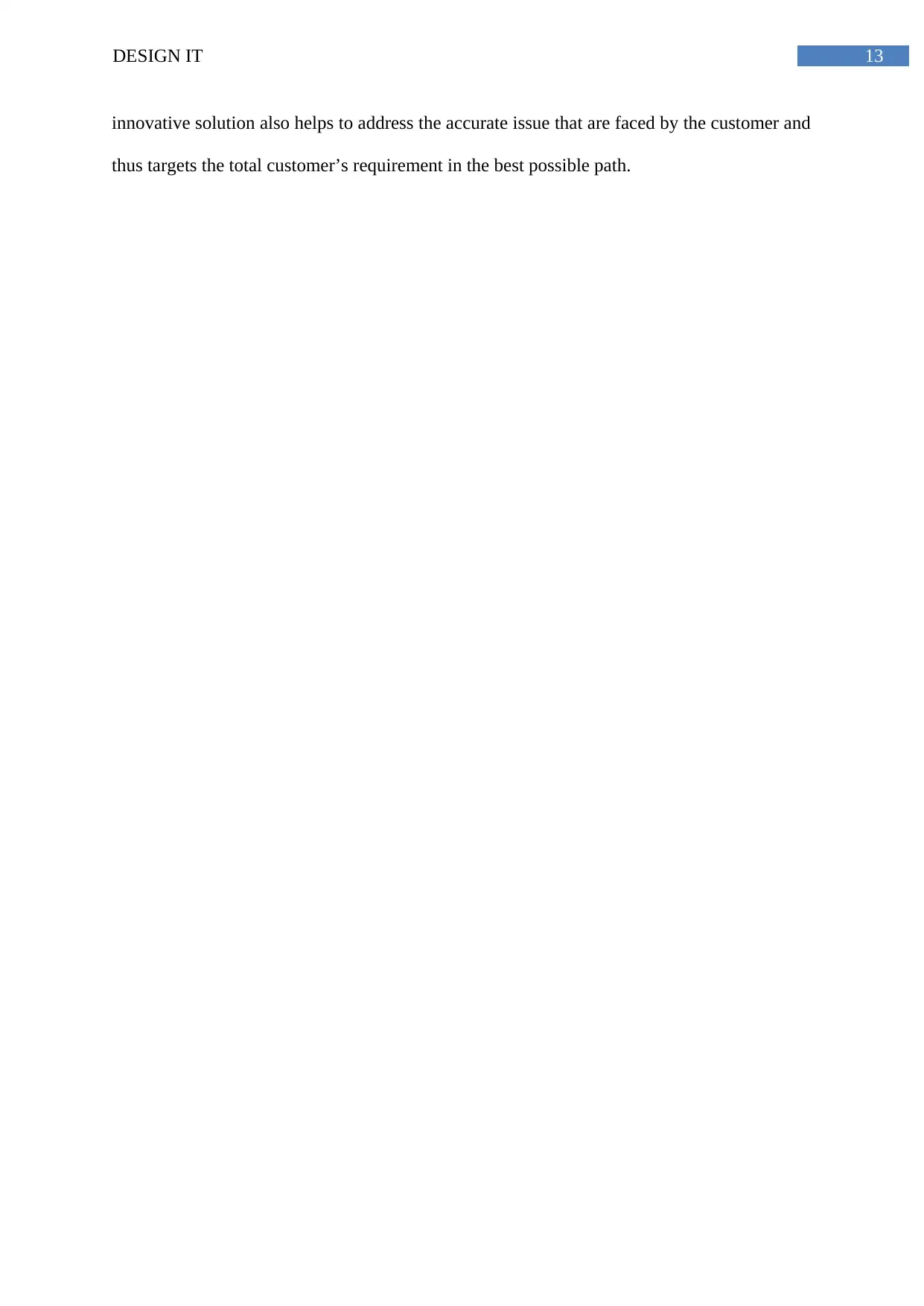
13DESIGN IT
innovative solution also helps to address the accurate issue that are faced by the customer and
thus targets the total customer’s requirement in the best possible path.
innovative solution also helps to address the accurate issue that are faced by the customer and
thus targets the total customer’s requirement in the best possible path.
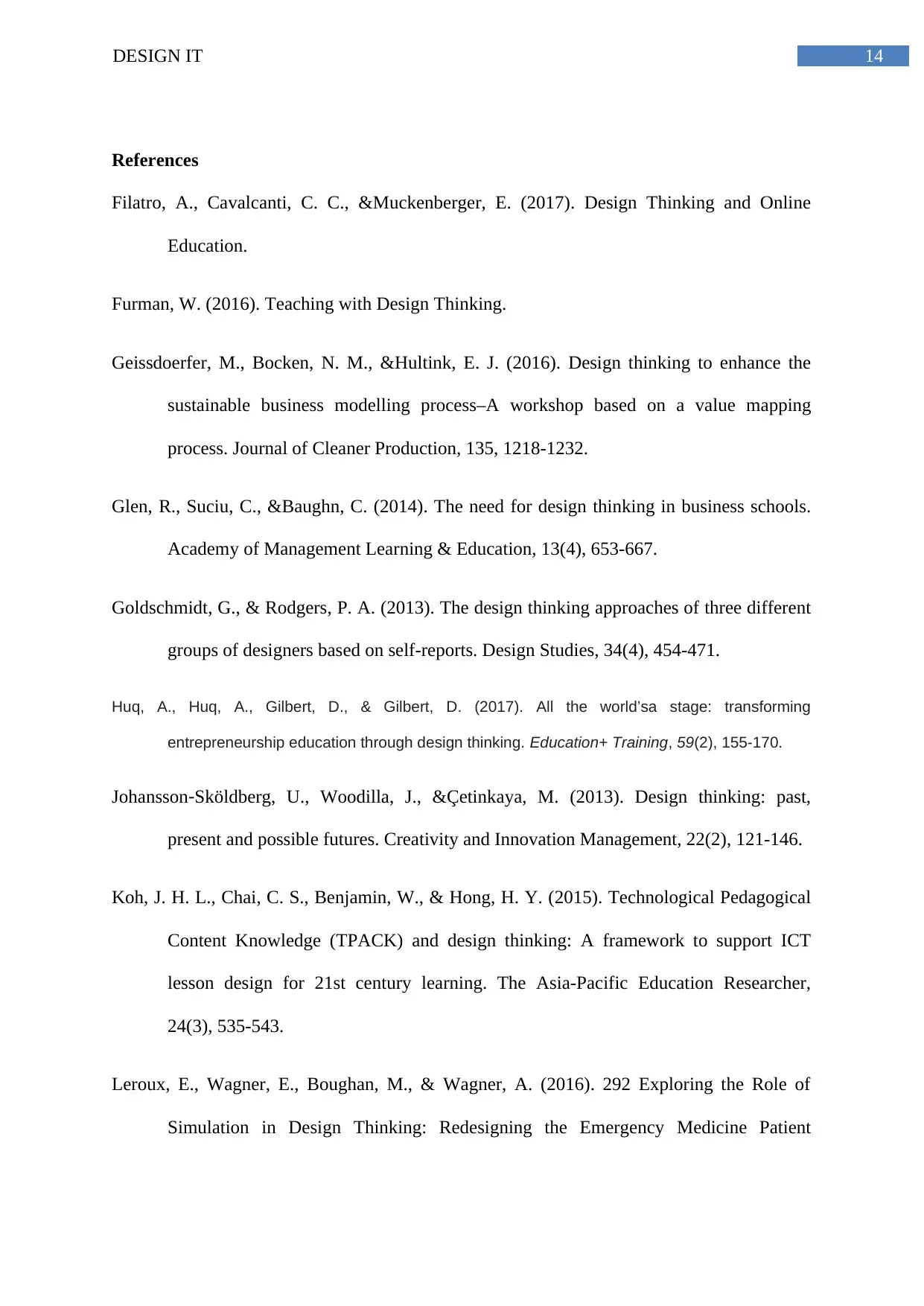
14DESIGN IT
References
Filatro, A., Cavalcanti, C. C., &Muckenberger, E. (2017). Design Thinking and Online
Education.
Furman, W. (2016). Teaching with Design Thinking.
Geissdoerfer, M., Bocken, N. M., &Hultink, E. J. (2016). Design thinking to enhance the
sustainable business modelling process–A workshop based on a value mapping
process. Journal of Cleaner Production, 135, 1218-1232.
Glen, R., Suciu, C., &Baughn, C. (2014). The need for design thinking in business schools.
Academy of Management Learning & Education, 13(4), 653-667.
Goldschmidt, G., & Rodgers, P. A. (2013). The design thinking approaches of three different
groups of designers based on self-reports. Design Studies, 34(4), 454-471.
Huq, A., Huq, A., Gilbert, D., & Gilbert, D. (2017). All the world’sa stage: transforming
entrepreneurship education through design thinking. Education+ Training, 59(2), 155-170.
Johansson‐Sköldberg, U., Woodilla, J., &Çetinkaya, M. (2013). Design thinking: past,
present and possible futures. Creativity and Innovation Management, 22(2), 121-146.
Koh, J. H. L., Chai, C. S., Benjamin, W., & Hong, H. Y. (2015). Technological Pedagogical
Content Knowledge (TPACK) and design thinking: A framework to support ICT
lesson design for 21st century learning. The Asia-Pacific Education Researcher,
24(3), 535-543.
Leroux, E., Wagner, E., Boughan, M., & Wagner, A. (2016). 292 Exploring the Role of
Simulation in Design Thinking: Redesigning the Emergency Medicine Patient
References
Filatro, A., Cavalcanti, C. C., &Muckenberger, E. (2017). Design Thinking and Online
Education.
Furman, W. (2016). Teaching with Design Thinking.
Geissdoerfer, M., Bocken, N. M., &Hultink, E. J. (2016). Design thinking to enhance the
sustainable business modelling process–A workshop based on a value mapping
process. Journal of Cleaner Production, 135, 1218-1232.
Glen, R., Suciu, C., &Baughn, C. (2014). The need for design thinking in business schools.
Academy of Management Learning & Education, 13(4), 653-667.
Goldschmidt, G., & Rodgers, P. A. (2013). The design thinking approaches of three different
groups of designers based on self-reports. Design Studies, 34(4), 454-471.
Huq, A., Huq, A., Gilbert, D., & Gilbert, D. (2017). All the world’sa stage: transforming
entrepreneurship education through design thinking. Education+ Training, 59(2), 155-170.
Johansson‐Sköldberg, U., Woodilla, J., &Çetinkaya, M. (2013). Design thinking: past,
present and possible futures. Creativity and Innovation Management, 22(2), 121-146.
Koh, J. H. L., Chai, C. S., Benjamin, W., & Hong, H. Y. (2015). Technological Pedagogical
Content Knowledge (TPACK) and design thinking: A framework to support ICT
lesson design for 21st century learning. The Asia-Pacific Education Researcher,
24(3), 535-543.
Leroux, E., Wagner, E., Boughan, M., & Wagner, A. (2016). 292 Exploring the Role of
Simulation in Design Thinking: Redesigning the Emergency Medicine Patient
⊘ This is a preview!⊘
Do you want full access?
Subscribe today to unlock all pages.

Trusted by 1+ million students worldwide
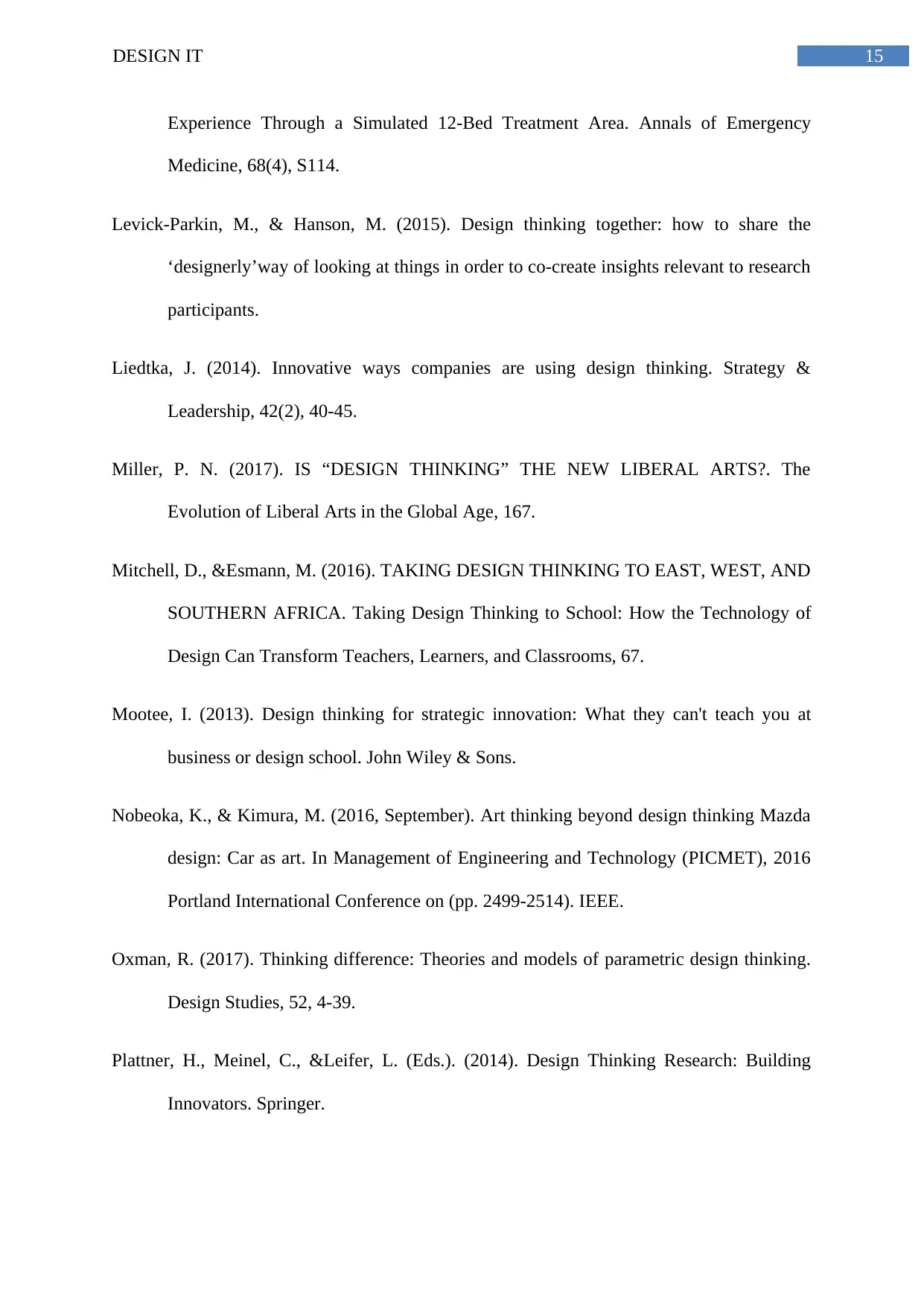
15DESIGN IT
Experience Through a Simulated 12-Bed Treatment Area. Annals of Emergency
Medicine, 68(4), S114.
Levick-Parkin, M., & Hanson, M. (2015). Design thinking together: how to share the
‘designerly’way of looking at things in order to co-create insights relevant to research
participants.
Liedtka, J. (2014). Innovative ways companies are using design thinking. Strategy &
Leadership, 42(2), 40-45.
Miller, P. N. (2017). IS “DESIGN THINKING” THE NEW LIBERAL ARTS?. The
Evolution of Liberal Arts in the Global Age, 167.
Mitchell, D., &Esmann, M. (2016). TAKING DESIGN THINKING TO EAST, WEST, AND
SOUTHERN AFRICA. Taking Design Thinking to School: How the Technology of
Design Can Transform Teachers, Learners, and Classrooms, 67.
Mootee, I. (2013). Design thinking for strategic innovation: What they can't teach you at
business or design school. John Wiley & Sons.
Nobeoka, K., & Kimura, M. (2016, September). Art thinking beyond design thinking Mazda
design: Car as art. In Management of Engineering and Technology (PICMET), 2016
Portland International Conference on (pp. 2499-2514). IEEE.
Oxman, R. (2017). Thinking difference: Theories and models of parametric design thinking.
Design Studies, 52, 4-39.
Plattner, H., Meinel, C., &Leifer, L. (Eds.). (2014). Design Thinking Research: Building
Innovators. Springer.
Experience Through a Simulated 12-Bed Treatment Area. Annals of Emergency
Medicine, 68(4), S114.
Levick-Parkin, M., & Hanson, M. (2015). Design thinking together: how to share the
‘designerly’way of looking at things in order to co-create insights relevant to research
participants.
Liedtka, J. (2014). Innovative ways companies are using design thinking. Strategy &
Leadership, 42(2), 40-45.
Miller, P. N. (2017). IS “DESIGN THINKING” THE NEW LIBERAL ARTS?. The
Evolution of Liberal Arts in the Global Age, 167.
Mitchell, D., &Esmann, M. (2016). TAKING DESIGN THINKING TO EAST, WEST, AND
SOUTHERN AFRICA. Taking Design Thinking to School: How the Technology of
Design Can Transform Teachers, Learners, and Classrooms, 67.
Mootee, I. (2013). Design thinking for strategic innovation: What they can't teach you at
business or design school. John Wiley & Sons.
Nobeoka, K., & Kimura, M. (2016, September). Art thinking beyond design thinking Mazda
design: Car as art. In Management of Engineering and Technology (PICMET), 2016
Portland International Conference on (pp. 2499-2514). IEEE.
Oxman, R. (2017). Thinking difference: Theories and models of parametric design thinking.
Design Studies, 52, 4-39.
Plattner, H., Meinel, C., &Leifer, L. (Eds.). (2014). Design Thinking Research: Building
Innovators. Springer.
Paraphrase This Document
Need a fresh take? Get an instant paraphrase of this document with our AI Paraphraser
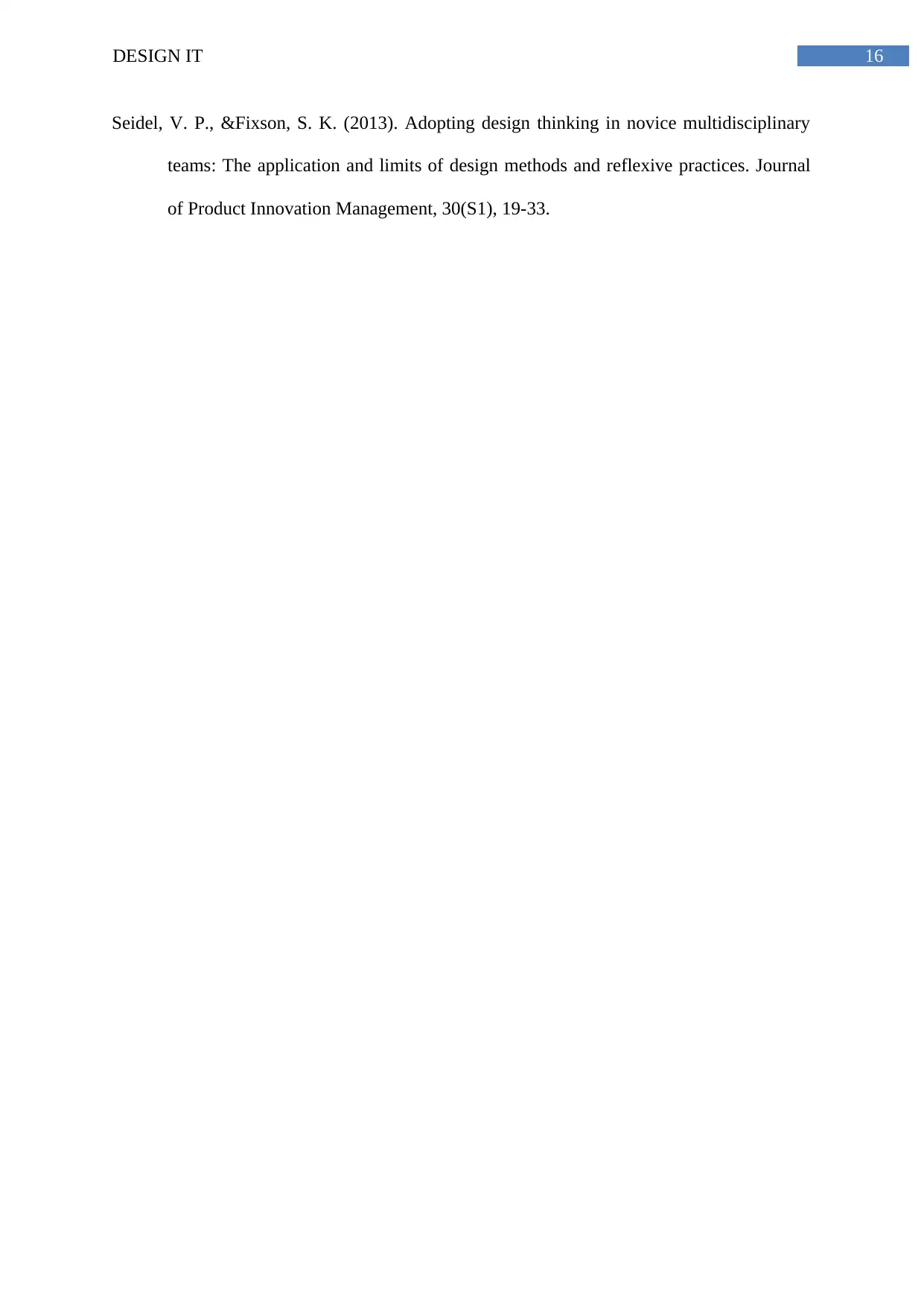
16DESIGN IT
Seidel, V. P., &Fixson, S. K. (2013). Adopting design thinking in novice multidisciplinary
teams: The application and limits of design methods and reflexive practices. Journal
of Product Innovation Management, 30(S1), 19-33.
Seidel, V. P., &Fixson, S. K. (2013). Adopting design thinking in novice multidisciplinary
teams: The application and limits of design methods and reflexive practices. Journal
of Product Innovation Management, 30(S1), 19-33.
1 out of 17
Related Documents
Your All-in-One AI-Powered Toolkit for Academic Success.
+13062052269
info@desklib.com
Available 24*7 on WhatsApp / Email
![[object Object]](/_next/static/media/star-bottom.7253800d.svg)
Unlock your academic potential
© 2024 | Zucol Services PVT LTD | All rights reserved.





